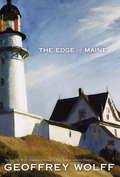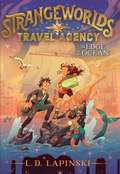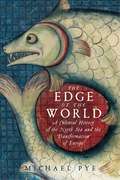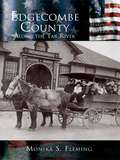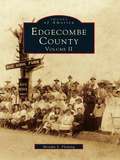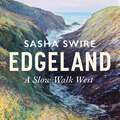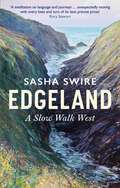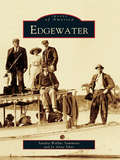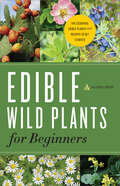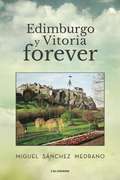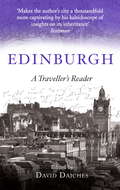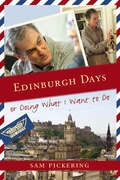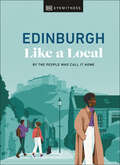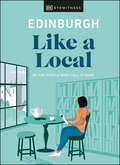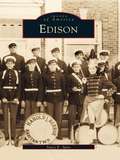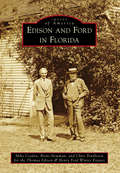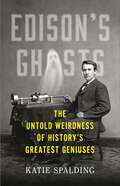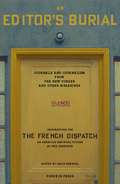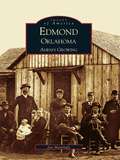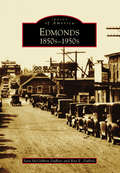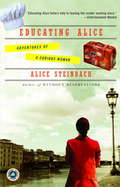- Table View
- List View
The Edge of Maine
by Geoffrey WolffNow, with the voice of a passionate insider, he brings readers into the heart of this striking region and explains what makes it unique. Starting with a gripping tale about being lost offshore in the fog with inadequate navigational aids, Wolff goes on to describe the coast's geological history and discovery by Europeans. He then turns a keen eye towards Mainers, their mores and peculiarities, and to the summer rusticators who for generations have invaded the stunning waterfronts. A section on boat building celebrates the extraordinary rescue of Maine's foremost craft; another on lobsters tells the rich story of the custom, taste, commerce, environmental conflict, and scientific mystery surrounding these critical crustaceans. Here is a true feast--travel literature at its best.
The Edge of the Ocean (Strangeworlds Travel Agency #2)
by L. D. LapinskiFlick tries to save a watery world from total destruction in this magical second book in the Strangeworlds Travel Agency series. Flick is now a badge-wearing member of the Strangeworlds Travel Agency, so when an urgent summons arrives at from Pirate Queen Nyfe, she and Strangeworlds Society guardian Jonathon immediately pack their bags for an adventure to The Break, a world of magic and piracy. Nyfe&’s world is falling apart. The Break is used to having ships vanish without a trace, but there has been a sudden increase that can&’t be explained by giant squid or merpeople. The edge of their flat world is coming ever closer to them and they need to escape before it collapses entirely. But how do you sail a ship through a suitcase? Or fit in a mer-queen the size of a whale? Flick and Jonathan must find a way to transport the inhabitants of the Break to another world before theirs disappears forever.
The Edge of the World: A Cultural History of the North Sea and the Transformation of Europe
by Michael PyeAn epic adventure ranging from the terror of the Vikings to the golden age of cities: Michael Pye tells the amazing story of how modernity emerged on the shores of the North Sea. Saints and spies, pirates and philosophers, artists and intellectuals: they all criss-crossed the grey North Sea in the so-called "dark ages," the years between the fall of the Roman Empire and the beginning of Europe's mastery over the oceans. Now the critically acclaimed Michael Pye reveals the cultural transformation sparked by those men and women: the ideas, technology, science, law, and moral codes that helped create our modern world. This is the magnificent lost history of a thousand years. It was on the shores of the North Sea where experimental science was born, where women first had the right to choose whom they married; there was the beginning of contemporary business transactions and the advent of the printed book. In The Edge of the World, Michael Pye draws on an astounding breadth of original source material to illuminate this fascinating region during a pivotal era in world history.
Edgecombe County: Along the Tar River
by Monika S. FlemingEdgecombe County, in the coastal plains of North Carolina along the Tar River, was once home to the Tuscarora tribes and was founded by English immigrants from Virginia. The county swelled as an agricultural center in the cotton and textile industries, bolstered by a wealth of lumber and sustained by a thriving inland river port and railroad. Though the residents struggled through natural, industrial, and economic upheaval, their courage and fortitude endured these hardships and unified their community.
Edgecombe County: Volume II (Images of America)
by Monika S. FlemingEdgecombe County is a unique combination of beautiful pastoral scenery and strong, interestingpeople. Communities like Pinetops, Whitakers, Speed, Leggett, and Conetoe provide an excellent insight into the struggles and triumphs of traditionalAmerican small towns. In this highly anticipatedsecond volume, you will explore the social identity of Edgecombe County by taking visual tours of severalhistoric neighborhoods, schools, and churches. As with any successful region, Edgecombe County's greatest resource is its people, for the area has provided a wealth of talented citizens to the political arena, military battlefronts, the playing fields of professional sports, and the artistic community. This collection of images also honors the countless men and women who persevered through the county's periods of war, depression, and natural disaster and continued to support one another in times of need and adversity.
Edgeland: A Slow Walk West
by Sasha SwireFrom the bestselling author of Diary of an MP's Wife comes a beautiful discovery of Britain's great coastal pathIn Edgeland, the political diarist Sasha Swire escapes the confines of Westminster to walk the northern stretch of the South West Coast Path. Starting at Minehead in Somerset, she follows the well-trodden path to Land's End in Cornwall, walking it in sections over a decade-long period, returning each year like a migratory bird.The result is an immersive, beguiling and literary exploration of one of the most enigmatic, beautiful and popular coastlines on earth. It is also a contemplative and very personal response to a story about our English shore from pre-Celtic times to the present day; of the upheaval of rocks; of astonishing botany; of pilgrimage and customs; of the exploitation of resources and of dangers to come.Swire identifies how important edges are to us as she walks, not only in how we see our world but in our attitude to it. She observes that the outside limits, the borders, the line where two surfaces of a solid meet actively, encourage not only flora and fauna but people to gather, create, generate resistance and build new ways of living and working.She discovers that the path is not only a walk through Britain's windswept and wave-battered western fringes but a tale about how we and nature have, through extraordinary resilience and relentless spirit, learnt to tame the various forces that are stacked against us. That we live at the edge of the possible.
Edgeland: A Slow Walk West
by Sasha SwireFrom the bestselling author of Diary of an MP's Wife comes a beautiful discovery of Britain's great coastal pathIn Edgeland, the political diarist Sasha Swire escapes the confines of Westminster to walk the northern stretch of the South West Coast Path. Starting at Minehead in Somerset, she follows the well-trodden path to Land's End in Cornwall, walking it in sections over a decade-long period, returning each year like a migratory bird.The result is an immersive, beguiling and literary exploration of one of the most enigmatic, beautiful and popular coastlines on earth. It is also a contemplative and very personal response to a story about our English shore from pre-Celtic times to the present day; of the upheaval of rocks; of astonishing botany; of pilgrimage and customs; of the exploitation of resources and of dangers to come.Swire identifies how important edges are to us as she walks, not only in how we see our world but in our attitude to it. She observes that the outside limits, the borders, the line where two surfaces of a solid meet actively, encourage not only flora and fauna but people to gather, create, generate resistance and build new ways of living and working.She discovers that the path is not only a walk through Britain's windswept and wave-battered western fringes but a tale about how we and nature have, through extraordinary resilience and relentless spirit, learnt to tame the various forces that are stacked against us. That we live at the edge of the possible.
Edgewater (Images of America)
by Sandra Wallus Sammons Jo Anne Sikes"Do you want a beautiful winter home in Florida? Located on the highest, driest, healthiest, and most beautiful spot for a town . . ." This land company advertisement is like many we see today in Florida, but it was written over 100 years ago by the founder of Hawks Park, Dr. John Milton Hawks. Hawks Park was established in 1871, and within 15 years, it had 115 permanent residents and was a popular place for many Northerners to enjoy the warm winters along the edge of the beautiful Indian River. By 1925, the growing community became a town and adopted the more descriptive name of Edgewater. While there are more than 20,000 residents in 2005, the population of the city still swells during the winter when people follow the migrating birds and boats, seeking refuge from the snow. Although much has changed since the founding of Edgewater, rare vintage photographs will take the readers through the town's years of growth in this illustrative history.
Edible Wild Plants for Beginners: The Essential Edible Plants and Recipes to Get Started
by Althea PressDig up a whole new culinary world with this New York Times best-selling field guide to foraging Most of us "forage" for food in the aisles of well-lit grocery stores. But there are delicious edible plants for the taking right outside your door! This all-in-one reference shows you how to identify 31 of the most common edible wild plants in North America, from California to Connecticut. Gather your gear—Dive into edible plant history and foraging FAQs, and learn what tools you'll need before you head out. Spot the snacks—Find photos, descriptions, distinguishing characteristics, and common uses for 31 edible wild plants—from arrowroot to wild rose. Recipes and remedies—Learn to use wild plants in everything from curry and cookies to bug bite balm and bath soaks. Stay safe—This book includes foraging guidelines that are vital to your safety. It's recommended you read it in its entirety before you explore. Make the most of what Mother Nature has to offer with Edible Wild Plants for Beginners.
Edimburgo y Vitoria forever
by Miguel Sánchez MedranoViajar en familia, aprender en familia, disfrutar en familia. El relato cuenta los gozos y dificultades de una familia alavesa, la pareja, Miguel y Verónica, y sus dos hijos adolescentes, Javier y Loreto. <P><P>Dejan su cómoda vida en Vitoria y establecen su residencia en la capital escocesa, con todo el espectro de problemas que esto conlleva de adaptación: escolarización, nuevas amistades, diferentes usos sociales y culturales, choque de mentalidades y dificultades idiomáticas. <P><P>El relato está lleno de reflexiones críticas y comentarios personales sobre las diferencias y semejanzas entre la sociedad escocesa, vasca y española; entre la cultura anglosajona, protestante, y los modos y maneras de nuestra cultura católica y latina; entre el nacionalismo escocés y el nacionalismo vasco; entre lo británico y lo español... <P>Todo ello en un tono coloquial, personal, sincero y desenfadado. Esta veta y las tensiones y dificultades que derivan de la presencia de un adolescente en casa dan un especial interés al relato. <P><P>El narrador hace gala de un carácter gruñón pero sentimental, lleno de buenas intenciones y con una buena capacidad de observación de los detalles de la vida cotidiana que diferencian la sociedad escocesa, vasca y española.
Edinburgh: A Traveller's Reader (Traveller's Companions Ser.)
by David DaichesEdinburgh is a city whose history is written on its face. The Old Town on its crowded rock, sloping down from the Castle to Holyroodhouse, has not significantly changed its atmosphere since the turbulent fifteenth and sixteenth centuries, when riots, processions, or public executions jammed the High Street. And the very different era that followed the bloody religious wars of the seventeenth century is epitomized by the elegant streets and squares of the New Town - the eighteenth-century Enlightenment whose writers, philosophers and lawyers made Edinburgh famous. This anthology of extracts from letters, memoirs, diaries, novels and biographies of interesting visitors and inhabitants, including the writings of Scott, Boswell, Cockburn, John Knox and many others, recreates for today's visitors the drama, the history, and the life of the city in buildings and places that can still be visited. The daring Scottish recapture of the Castle from the English in 1313; the confrontation between Calvinist John Knox and Catholic Mary Queen of Scots in Holyroodhouse; an eye-witness account of the execution of Montrose at the Mercat Cross in 1650; reeking slop-pails in the wynds and polite manners in the ballrooms. . .
Edinburgh: A Traveller's Reader (A Traveller's Companion)
by Prof David DaichesEdinburgh is a city whose history is written on its face. The Old Town on its crowded rock, sloping down from the Castle to Holyroodhouse, has not significantly changed its atmosphere since the turbulent fifteenth and sixteenth centuries, when riots, processions, or public executions jammed the High Street. And the very different era that followed the bloody religious wars of the seventeenth century is epitomized by the elegant streets and squares of the New Town - the eighteenth-century Enlightenment whose writers, philosophers and lawyers made Edinburgh famous. This anthology of extracts from letters, memoirs, diaries, novels and biographies of interesting visitors and inhabitants, including the writings of Scott, Boswell, Cockburn, John Knox and many others, recreates for today's visitors the drama, the history, and the life of the city in buildings and places that can still be visited. The daring Scottish recapture of the Castle from the English in 1313; the confrontation between Calvinist John Knox and Catholic Mary Queen of Scots in Holyroodhouse; an eye-witness account of the execution of Montrose at the Mercat Cross in 1650; reeking slop-pails in the wynds and polite manners in the ballrooms. . .
Edinburgh: Picturesque Notes
by Robert Louis StevensonFirst published in 1879, Edinburgh: Picturesque Notes is among the most vivid of Robert Louis Stevenson’s writings. His passion for Auld Reekie never clouded his wry wit, and his enthusiasm for the picturesque detail and the savory anecdote will delight readers today as much as they scandalized his contemporaries. Perhaps best known as the author of Treasure Island and other children’s literature, Robert Louis Stevenson was a prolific novelist, playwright, essayist, and travel writer.
Edinburgh Days: Or Doing What I Want to Do
by Sam PickeringTales of meandering walks through Scotland&’s capital by an essayist known for &“often hilarious, sometimes poignant, takes on life&” (The New York Times). After a forty-year absence from the city, Sam Pickering—author, literary scholar, and inspiration for the lead character in Dead Poets Society—came to the University of Edinburgh on a fellowship in 2004. Edinburgh Days maps the transition from his life in Connecticut, defined by family, academic appointments, and the recognition of neighbors and avid acolytes, to a temporary existence on foreign soil that is at once unsettlingly isolating and curiously liberating. Part travelogue, part psychological self-study, it&’s a walking tour of the Scottish capital as well as through the labyrinth of Pickering&’s swerving moods and memories—and a look at what befalls the curious mind of an intellectual removed from the relations and responsibilities that otherwise delineate his days. His daily explorations include Edinburgh Castle, the Palace of Holyroodhouse, Castle Rock, the Museum of Childhood, the National Gallery, the Writers&’ Museum, the Museum of the People, the Huntly House, the John Knox House, the Royal Botanic Garden, and the Edinburgh Zoo, as well as neighborhood pubs, antique stores, and bookshops. Between his ambling tours, he revisits the works of writers renowned and obscure, including Robert Louis Stevenson, Samuel Smiles, John Buchan, Tobias Wolff, Russell Hoban, Patrick White, Hilaire Belloc, and Van Wyck Brooks. But it is not so much his erudition as his fascination with minutiae that infuses these essays with dynamic descriptions, quirky observations, and jesting interludes that bring the historic city to life. &“As he travels the damp, cobalt-gray streets of the great northern city, we rummage with him in old shops, follow him through gardens and graveyards, and see oft-visited monuments and museums through his fresh eyes . . . prose that glistens with natural details and an unapologetic delight in the foibles of humankind at its most genuine. We are fortunate to have Pickering as our tour guide.&” —Jay Parini, author of Borges and Me
Edinburgh Like a Local: By the People Who Call It Home (Local Travel Guide)
by Michael Clark DK Eyewitness Kenza Marland Stuart Kenny Xandra Robinson-BurnsThis isn't your ordinary travel guide. Beyond Edinburgh's iconic arts festival and hilltop castle are beautifully curated galleries, haunted alcoves, and secret distilleries in old railway buildings - and that's where this book takes you. Turn the pages to discover: The small businesses and community strongholds that add character to this vibrant city, recommended by true locals6 themed walking tours dedicated to specific experiences such as thrift store shopping and gin tastingA beautiful gift book for anyone seeking to explore EdinburghHelpful what3word addresses so that you can pinpoint all the listed sightsA range of sights and establishments that will take you well beyond the beaten pathCompiled by four proud Edinburgh residents, this stylish travel guide is packed with Edinburgh's best experiences and secret spots, handily categorized to suit your mood, whether you're a restless Edinburger on the hunt for a new hangout or a visitor keen to discover a side you won't find in traditional guidebooks, Edinburgh Like A Local will give you all the inspiration you need.Looking for another guide to Edinburgh? Explore further with our DK Eyewitness or Top 10 guides to Scotland.
Edinburgh Like a Local: By the people who call it home (Local Travel Guide)
by DK Eyewitness Kenza Marland Michael Clark Stuart Kenny Xandra Robinson-BurnsHome to winding cobblestoned streets, sprawling leafy parks, and an art scene like no other — traveling to Edinburgh is endlessly enticing.This insider&’s travel guide is packed with recommendations and tips from Edinburgers in the know, ensuring an authentic experience of this idyllic city, off the tourist track.It&’s not all about Edinburgh Castle and the National Museums. Beyond the well-trodden sights, there&’s a secret side of the city. This travel guide to Edinburgh includes: • Two-color, bold modern design with contemporary illustrations throughout • Authors are true locals and have been picked for having their fingers on the pulse and their diverse tastes. Their suggestions and advice sit alongside quotes from Edinburgh creatives, performers, volunteers and business leaders to give the book a local feel • Narrative style throughout, making the local, personal voice central to every entry • Structured by six themes and subsequent sub-themes: Eat, Drink, Shop, Art and Culture, Nightlife, and Outdoors • Each entry includes its unique address so readers can pinpoint precisely where they are heading • Each theme ends with a tour spread, dedicated to a specific interest or experience. For example, A Literary Tour of Edinburgh Old Town or A Foodie Tour of Leith Walk Whether you&’re a local wanting to explore your home town or a seasoned traveler looking for your next adventure, this beautiful Edinburgh travel guide will uncover a world of favorite hangout spots and hidden gems. Enjoy the banter at an old-school Leith boozer, brace yourself for a chilly dip at Portobello beach and browse indie boutiques that champion up-and-coming Scottish design in the elegant Georgian streets of the city's well-to-do West End.You&’ll find secret spots that only a local would know, hands-on experiences, and ideas for traveling solo, in a pair, or in a crowd. There&’s even a directory listing online resources dedicated to health and safety, accessibility, and places of worship as well as tips on how to travel sensibly in a post-Covid world without compromising on experience. Toss the usual tourist &“tick-list&”, and plan a trip to Edinburgh that you&’ll never forget! From New York and London to Paris and Amsterdam, there are more places to discover with these niche local guides! Written by the people who call it home, the Like A Local series from DK takes you beyond the tourist track to experience the heart and soul of each city!
Edison
by Stacy E. SpiesEdison, named for its most famous resident, inventor Thomas Alva Edison, can be called the birthplace of modern life as we know it. It was here at his Menlo Park complex that Thomas Edison created the incandescent electric lightbulb and 300 other inventions, providing residents with not only a place of employment but also a source of national pride. Known as Raritan Township until 1954, Edison was a slow-paced agricultural community until the twentieth century, with farms remaining until the 1950s. After World War II, in the country's rush to house returning war veterans, the expansive farmland became desirable real estate . Edison celebrates the township's history from its rural beginnings as a collection of small villages, to the arrival of the automobile culture on the Lincoln Highway and super highway U.S. Route 1, to its coming-of-age as a modern suburban community during the mid-twentieth century. This book combines photographs from the collections of the Metuchen-Edison Historical Society and the National Park Service, with some of the hundreds taken in the early years of the twentieth century by J. Lloyd Grimstead. Edison includes the many villages that make up the township: Oak Tree, Bonhamtown, Piscatawaytown, Stelton, New Durham, Pumptown Corners, New Dover, and Potters.
Edison and Ford in Florida (Images of America)
by Thomas Edison & Henry Ford Winter Estates Chris Pendleton Mike Cosden Brent NewmanProlific inventor Thomas Edison and automobile pioneer Henry Ford shaped the modern world like few others. The lives of these close friends intersected at their winter homes in southwest Florida. Edison first visited the tiny cattle-ranching community of Fort Myers in 1885, building a home and laboratory soon after. There, he wintered with his wife, Mina, and their children, Madeleine, Charles, and Theodore. Ford purchased the adjacent estate in 1916, wintering in the area with his wife, Clara, and son, Edsel. Here in southwest Florida, these famous neighbors relaxed and found time to explore new projects.
Edison's Ghosts: The Untold Weirdness of History's Greatest Geniuses
by Katie SpaldingPublishers Weekly Best Summer Reads Overturn everything you knew about history&’s greatest minds in this raucous and hilarious book, where it turns out there's a finer line between "genius" and "idiot" than we've previously known. &“As Albert Einstein almost certainly never said, everyone is a genius – but if you judge a fish by its ability to climb a tree, it will live its whole life believing that it is stupid.&” So begins Katie Spalding&’s spunky takedown of the Western canon, and how genius may not be as irrefutably great as we commonly understand. While most of us may never become Einstein, it may surprise you to learn that there&’s probably a bunch of stuff you can do that Einstein couldn&’t. And, as Spalding shows, the famous prodigies she explores here were quite odd by any definition. For example: Thomas Edison, inventor of the lightbulb, believed that he could communicate with the undead and built the world&’s very first hotline to heaven: the Spirit Phone. Marie and Pierre Curie, famous for discovering radioactivity, slept next to a lump of radioactive material for years and strapped it to their arms to watch it burn them in real-time. Lord Byron, acclaimed British poet, literally took a bear with him to university. Isaac Newton discovered the laws of gravity and motion, but he also looked up at the sun without eye protection. The result? Three days of blindness. Tesla, whose scientific work led to the invention of the AC unit, fell in love with a pigeon. Edison's Ghosts is filled with examples of the so-called best of humanity doing, to put it bluntly, some really dumb shit. You&’ll discover stories that deserve to be told but never are: the hilarious, regrettable, and downright bafflingly lesser-known achievements that never made it into our history books, until now.
An Editor’s Burial: Journals and Journalism from the New Yorker and Other Magazines
by Wes Anderson VariousA scintillating collection of inspirations for Wes Anderson's star-studded tenth film The French Dispatch--fascinating essays on the expatriate experience in Paris by some of the twentieth century's finest writers.A glimpse of post-war France through the eyes and words of 14 (mostly) expatriate journalists including Mavis Gallant, James Baldwin, A.J. Liebling, S.N. Behrman, Luc Sante, Joseph Mitchell, and Lillian Ross; plus, portraits of their editors William Shawn and New Yorker founder Harold Ross. Together: they invented modern magazine journalism. Includes an introductory interview by Susan Morrison with Anderson about transforming fact into a fiction and the creation of his homage to these exceptional reporters.
Edmond Oklahoma: Always Growing
by Jan MattinglyFrom its humble beginnings in 1886 as a fuel and water pump house at Mile Marker 103 of the Santa Fe Railroad, through the eras of land run, statehood, oil boom, two world wars and beyond, the city of Edmond has always been growing. Today, a "beacon for the rest of Oklahoma," it boasts a vibrant community of over 70,000 residents. Edmond is home to the state's oldest continuously running newspaper, the Edmond Sun. The first church and schoolyard in Oklahoma Territory were located here, as well as the state's first institute for higher learning. Indeed, Central Normal School, now called the University of Central Oklahoma, has been at the heart of Edmond since the 1890s and is featured prominently throughout this book. Edmond is a railroad town, an oil town and a college town, depending on who you ask; but Edmondites both past and present simply know it as the "perfect town." Edmond, Oklahoma: Always Growing tells the story of this proud city through more than two hundred vintage photographs, many dating back to before the turn of the twentieth century.
Edmonds: 1850s–1950s
by Sara Mcgibbon Dubois Ray E. DuboisBefore Edmonds became a town, it was a forest of cedar trees and evergreens. The Puget Sound's various Indian tribes used the land for camping, the sea for fishing and clamming for meals, and the marshes for harvesting tules that they used to weave into items such as mats and baskets. Later, the area became known as Brackett's Landing, named after the man who began logging the forest and founded the town of Edmonds in 1890 and opened its first mills and schools. The Great Northern Railway arrived in 1891, bringing with it great prospects for commercial and residential prosperity. As the young town grew into a city, it thrived because of its location on the water. Private ferry boats called the "Mosquito Fleet" came from Seattle, and to this day, commercial and passenger ferries cross the Puget Sound to the Port of Edmonds, Kingston, and the rest of the Olympic peninsula.
Educating Alice: Adventures of a Curious Woman
by Alice SteinbachEight years ago, Alice Steinbach, a Pulitzer Prize-winning columnist for the Baltimore Sun, decided to take a break from her life. She took a leave from job, friends, and family for a European journey of self-discovery, and her first book, Without Reservations, was the exquisite result.But once Steinbach had opened the door to a new way of living, she found herself unwilling to return to the old routine. She quit her job and left home again, only this time her objective was to ?nd a way that would allow her, personally and professionally, to combine three of her greatest passions: learning, traveling, and writing.This funny and tender book is the result of her decision to roam around the world as an informal student, taking lessons and courses in such things as French cooking in Paris, Border collie training in Scotland, traditional Japanese arts in Kyoto, architecture and art in Havana. With warmth and wit, Steinbach guides us through the pleasures and perils of discovering how to be a student again. Along the way, she also learns the true value of this second chance at educating herself: the opportunity to connect with and learn from the people she meets on her journey.From the Hardcover edition.
Educating Alice: Adventures of a Curious Woman
by Alice SteinbachWhen Pulitzer-prize winning journalist Alice Steinbach decided to take a year off to explore Europe and rediscover what it was like to be an independent woman, she left her job, family, friends and routine behind. The result, WITHOUT RESERVATIONS, became a bestseller and inspired women everywhere to take that leap, if not in reality, at least in their imaginations. But having opened the door to a new way of living, Steinbach found herself unwilling to return to the old routine. She quit her job and left home again, only this time her objective was to find a way to combine three of her greatest passions: travelling, writing and learning. EDUCATING ALICE is the intimate, funny and richly entertaining story of her adventures roaming the world to conquer new challenges, large and small. Whether she is learning how to cook at the Hotel Ritz in Paris, tackling the intricacies of traditional Japanese arts in Kyoto, making a pilgrimage to Jane Austen's birthplace in England, uncovers the secrets of border collie training in Scotland or surrendering to the spontaneous joy of music and memories in Havana, Steinbach allows you to relish the adventure with her.
Education for Sustainability in Tourism
by Gianna Moscardo Pierre BenckendorffSustainability is a dominant theme in tourism practice. Increasingly, research and education of tourism stakeholders is also necessary in improving sustainable tourism practice. This book pays systematic attention to education for sustainability in tourism, and is thus a valuable resource for sustainable tourism educators and scholars. The book is divided into four parts. Part I provides a reference for educators seeking to understand core knowledge areas, ethics, corporate social responsibility and governance. Part II examines issues and processes relevant to understanding tourism and sustainability in the formal educational sector, including universities, vocational training and school settings. Part III explores learning and sustainable tourism in non-institutional settings, including destination communities, coaching and mentoring and visitor learning. The final part provides a collection of cases to illustrate the use of different pedagogies and assessment approaches in education for sustainability in tourism. The book will be accompanied by instructor resources to assist educators teaching in the field.
